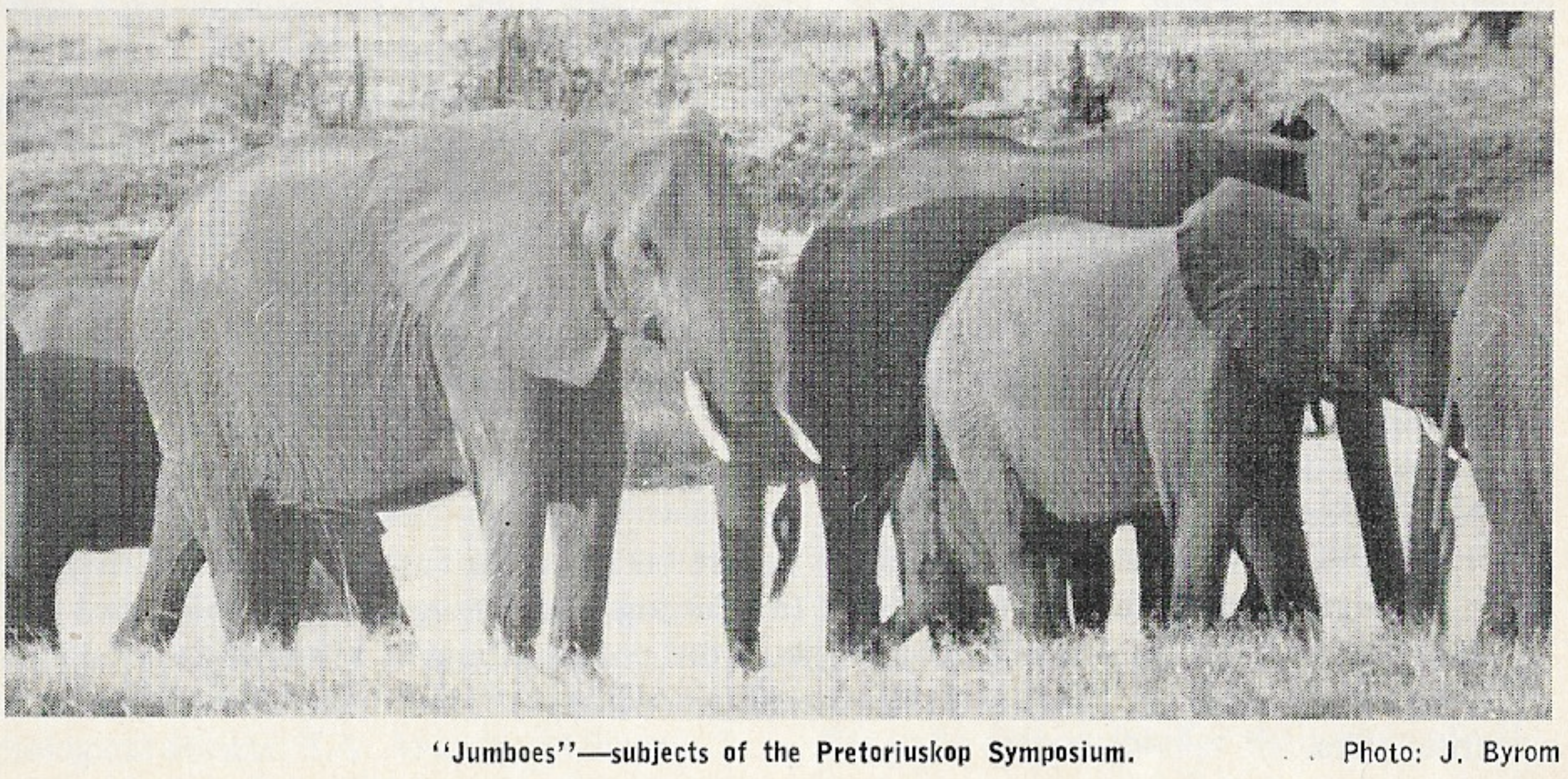A Wildlife Symposium, organised by the Natal Fieldwork Section, was held at Pretoriuskop, South Africa, from the 15th to the 20th May 1968, 53 years ago. In this article, Mr. T. C. Robertson, who presided, gives his impressions of the main theme of the papers and discussions.
The article is enlightening and begs the questions, how could the animal rights movement hijack science in conservation? Why is public opinion more important than research?
FIREBUGS AND JUMBOES IN THE ECOSYSTEM
Beside a track cut into coarse sandy soil, derived from the old granite inselbergs of the Lowveld, members of the Natal Fieldwork Section of the Wildlife Society were up to their waists in grass.
They were contemplating a number of experimental plots to the east of the road that goes from Numbi Gate to the Hippo Pools in the Kruger Park.
Here the periodicity of deliberate burning had been controlled in an attempt to determine its effect on this veld type-the succession of the grasses and the constituents of the vegetation.
Much patient botanical surveying had obviously gone into the work.
The next afternoon, a few miles away, they watched the flames and smoke of an “accidental burn”, started by some unscientific human agency.
That evening, as sparks from a big log fire and the aroma of boerewors rose into the still night air, some of the indefatigable enthusiasts, anticipating the subject of the next morning’s symposium paper, discussed the basic nature of the problem that was suggested by the day’s events.
Veld burning on a farm or experimental station assumes control over all the variables in the ecological equation.
In the Kruger Park only the season and frequency of the burn is under control not the grazing animals.
To get such control, a few expensive “elephant proof” plots are to be constructed.
As it happened, the elephant and not the firebug became the star turn of the symposium. Bill Bainbridge explained how there had been something of a “population explosion” of the herds in Zambia’s Luangwa Valley, unleashing 27,000 of the huge beasts to destroy Mopani forest and even graze down the giant baobabs.
Control involves the destruction of whole family parties so as not to cause unnecessary alarm-by the crossbow and “drug bullets”; carcasses are taken on low-loaders out of the bush to ten-ton lorries and conveyed to a big central a abattoir from where the meat is marketed as frozen or canned “Jumbo” to the protein hungry Zambians.
Visiting American professors showed colour slides to illustrate methods of marking the Lungwa elephants so that their life cycles, herd organisation, migratory routes, ecological niches and ethology of behaviour could be studied.
The eventual aim is to quantify the ecosystem so that mathematical models for computer analysis can be constructed.
This method is now being applied to farming systems (e.g. Canada’s IBP project at Metador) and may also become an important tool in wildlife management.
Luangwa, the world’s biggest game park, stimulates this kind of thinking about its vastness and its problems. Survey of a sample section of 10,000 square miles revealed an elephant population of 23,000, with concentrations at places of up to 20 per square mile. Along a river frontage of 300 miles 8,000 hippo and 15,000 buffalo were sighted.
Habitat degradation is further aggravated by a change in the grazing habits of the Lechwe (Onotragus leche). As Selous pointed out long ago, they are more of a “Water Antelope” than the Waterbuck or Puku.
But they have forsaken marshy ground along the river for the grassland plains where they multiply by the thousands.
The tsetse fly makes the Luangwa Valley unsuited for domestic stock. But with scientific management and cropping on a sustained yield basis, it will a be a great source of meat in tropical Africa.
The biological puzzle it poses is to decide how, in a state of nature and without the intervention of man, the elephant population was limited without destruction of the habitat.
There were whispers on the symposium “campus”, but no official information, about the elephant problem in the Kruger Park.
In 1932 there were three family groups, about 150 animals, in the northern section of the Park.
The total is now approaching the 3,000 mark and cropping and utilisation of the meat has become essential.
(In 2021 Dr Ian Whyte, in his 24th census, counted 13 050 elephants in the Kruger National Park)
Details of the Natal Parks Board’s magnificent efforts to re-stock farms and educate farmers in wildlife management formed the subject of lengthy discussions.
This very successful little symposium gave a useful glimpse of what man is doing to understand and manage his natural environment in Africa. The task is so immense that the news of the establishment of a faculty of Wild Life Management at the Pretoria University will be welcomed.
Twenty years ago, when there was optimistic talk about the Dawn of the Age of Plenty,
the biotechnical future of man was seen as a “planned ecology of human life”.
We are now beginning to appreciate the complexity of the undertaking. But the task has become essential even in those areas where it was once the intention to “leave it to nature”.


